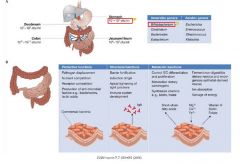![]()
![]()
![]()
Use LEFT and RIGHT arrow keys to navigate between flashcards;
Use UP and DOWN arrow keys to flip the card;
H to show hint;
A reads text to speech;
6 Cards in this Set
- Front
- Back
|
Mouth and pharynx
|
a. Large number of facultative and strict anaerobes
i. Neisseria spp. and Moraxella spp. most common facultatives b. Streptococcus spp. = buccal and tongue mucosa c. Anaerobes and microaerophiles = gingival crevices and tonsilar crypts d. Saliva = mixed flora i. ~108 microorganisms/ml |
|
|
Stomach
|
a. Few, if any, microbes
b. Mechanisms to prevent colonization i. Gastric HCl – inhospitable pH ii. Peptic enzymes – digests bacterial components iii. Defensins – produced by goblet cells and inserts into bacterial cell wall leading to bacterial osmotic lysis iv. Lysozyme - breaksdown gram-positive cell walls |
|
|
Small intestine
|
a. Scattered resident flora
b. No anaerobes c. Terminal ileum begins to resemble colonic flora d. Mechanisms to prevent colonization i. Peristalsis – motility prevents adherence of bacteria ii. Secretory IgA – antibody in mucosal lumen that binds and neutralizes bacteria iii. Bile acids – inhospitable pH for bacteria iv. Defensins – inserts into bacterial cell wall leading to bacterial osmotic lysis |
|
|
Large intestine
|
a. Sterile at birth
b. Rich flora by 1 month from oral to anal direction c. 90% anaerobic microbes i. Bacteroides spp. ii. Fusobacterium spp. iii. Eubacterium spp. iv. Clostridium spp. v. Bifidobacterium spp. d. 10% facultative microbes i. E. coli ii. Enterococcus spp. iii. Streptococcus spp. iv. Staphlococcus spp. e. Yeasts f. Flora depends on diet g. High meat diet increases the number of Bacteroides spp. and other Gram-negative rods in stools |
|
|
Colonic flora
|
a. Slow motility allows larger numbers of bacteria
b. Microorganisms kept in colon by ileocecal valve c. # of colonic bacteria is greater than the total # of cells in the human body d. Adult feces >25% bacteria by weight e. ~1010-12 microorganisms/gram f. > 500 taxonomically distinct species g. Functions i. Helps develop mucosal immune system ii. Epithelial proliferation and differentiation aided by luminal bacterium iii. Converts bilirubin to urobilirubin iv. Deconjugates conjugated bile acids that escape active reabsorption in the terminal ileum v. Ferment dietary fiber 1. Requires strict anaerobic environment 2. Produces short-chain fatty acids like acetate, proprionate, and butyrate 3. Produces gases like hydrogen, CO2, and methane vi. Degrades proteins to amino acids, CO2, and ammonia vii. Increases resistance to colonization by pathogens |
|
|
Diagram
|

|

